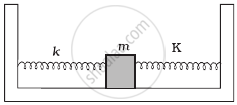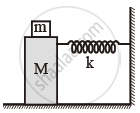Advertisements
Advertisements
प्रश्न
A mass attached to a spring is free to oscillate, with angular velocity ω, in a horizontal plane without friction or damping. It is pulled to a distance x0 and pushed towards the centre with a velocity v0 at time t = 0. Determine the amplitude of the resulting oscillations in terms of the parameters ω, x0 and v0. [Hint: Start with the equation x = acos (ωt+θ) and note that the initial velocity is negative.]
उत्तर १
The displacement equation for an oscillating mass is given by:
x = `A cos (omega t + theta)`
Where,
A is the amplitude
x is the displacement
θ is the phase constant
Velocity, `v = (dx)/(dt) = -Aomega sin(omega t + theta)`
At t = 0, x = x0
x0 = Acosθ = x0 … (i)
And, `(dx)/(dt) = -v_0 = Aomegasin theta`
`A sin theta = v_0/omega` ...(ii)
Squaring and adding equations (i) and (ii), we get:
`A^2(cos^2 theta + sin^2 theta)= x_0^2 + ((v_0^2)/(omega^2))`
`:. A= sqrt(x_0^2 + (v_0/omega)^2)`
Hence, the amplitude of the resulting oscillation is `sqrt(x_0^2 + (v_0/omega)^2)`
उत्तर २
x = `alpha cos (omegat + theta)`
`v = (dx)/(dt) = -aomega sin(omegat = theta)`
When t = 0, x = `x_0` and `dx/dt = -v_0`
x0 = `a cos theta`
and `-v_0 = -a omega sin theta` or a `sin theta = v_0/omega`
Squaring and adding (i) and (ii) we get
`a^2(cos^2 theta + sin^2 theta) = x_0^2 + (v_0^2)/(omega^2)`
or `a = sqrt(x_0^2 + v_0^2/omega^2)`
APPEARS IN
संबंधित प्रश्न
The acceleration due to gravity on the surface of moon is 1.7 ms–2. What is the time period of a simple pendulum on the surface of moon if its time period on the surface of earth is 3.5 s? (g on the surface of earth is 9.8 ms–2)
Answer the following questions:
The motion of a simple pendulum is approximately simple harmonic for small angle oscillations. For larger angles of oscillation, a more involved analysis shows that T is greater than `2pisqrt(1/g)` Think of a qualitative argument to appreciate this result.
Answer the following questions:
What is the frequency of oscillation of a simple pendulum mounted in a cabin that is freely falling under gravity?
The cylindrical piece of the cork of density of base area A and height h floats in a liquid of density `rho_1`. The cork is depressed slightly and then released. Show that the cork oscillates up and down simple harmonically with a period
`T = 2pi sqrt((hrho)/(rho_1g)`
where ρ is the density of cork. (Ignore damping due to viscosity of the liquid).
A clock regulated by seconds pendulum, keeps correct time. During summer, length of pendulum increases to 1.005 m. How much will the clock gain or loose in one day?
(g = 9.8 m/s2 and π = 3.142)
If the maximum velocity and acceleration of a particle executing SHM are equal in magnitude, the time period will be ______.
A particle executing S.H.M. has a maximum speed of 30 cm/s and a maximum acceleration of 60 cm/s2. The period of oscillation is ______.
Two identical springs of spring constant K are attached to a block of mass m and to fixed supports as shown in figure. When the mass is displaced from equilibrium position by a distance x towards right, find the restoring force

In the given figure, a mass M is attached to a horizontal spring which is fixed on one side to a rigid support. The spring constant of the spring is k. The mass oscillates on a frictionless surface with time period T and amplitude A. When the mass is in equilibrium position, as shown in the figure, another mass m is gently fixed upon it. The new amplitude of oscillation will be:

A particle at the end of a spring executes simple harmonic motion with a period t1, while the corresponding period for another spring is t2. If the period of oscillation with the two springs in series is T, then ______.
